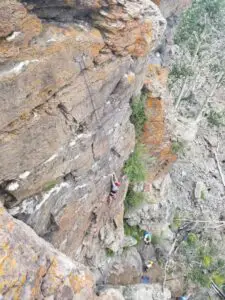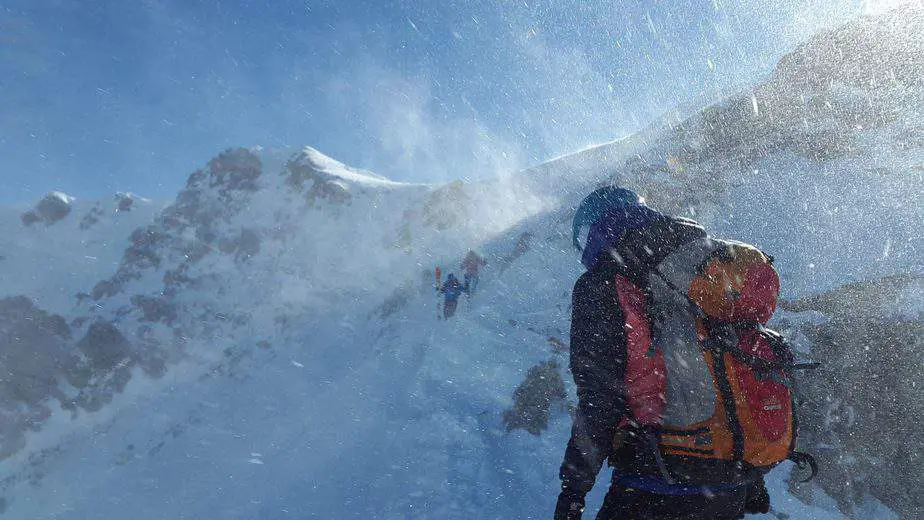Although their histories are intertwined, modern rock climbing and mountaineering are very different activities. Some of the most famous people from the 19th and 20th centuries were mountaineers and explorers, and though the allure of exploration has lessened, big first ascents still make the news on a regular basis.
Rock climbing has grown a lot in recent years thanks to improved safety equipment and the prevalence of indoor climbing gyms. Let’s look at the similarities and differences between mountaineering and rock climbing, and where they overlap.
Mountaineering, in its simplest form, is getting to the top of any given mountain. The most famous example is Mt. Everest. Usually, this involves high altitudes, bad weather, and technical prowess; however, attaining any peak could be considered mountaineering. It is generally considered very dangerous.
Rock Climbing is climbing vertically up rock faces, usually using ropes, harnesses, and protection like bolts or cams and nuts. It is also often practiced indoors. While still considered dangerous, it is generally safer than mountaineering for a variety of reasons.

How is Rock Climbing Different from Mountaineering?
Mountaineering and rock climbing have a shared history and origin, which you can read about in our article The Complete History of Rock Climbing . Explorers and scientists used rudimentary climbing techniques to reach the tops of rugged peaks. There are many reasons that rock climbing split off from traditional mountaineering and developed into its own lifestyle. Here’s a few:
. Explorers and scientists used rudimentary climbing techniques to reach the tops of rugged peaks. There are many reasons that rock climbing split off from traditional mountaineering and developed into its own lifestyle. Here’s a few:
- Training/Practice– Mountaineers first started climbing rocks as a way to train for the technical challenges they would face higher up the mountains. It’s a lot easier to train when you don’t have to worry about freezing to death, or proximity to medical care in the event of an injury.
- Danger Level– The farther away you get from civilization, the more difficult it is to get medical care. Helicopters can’t fly above certain altitudes, and unpredictable storms often make rescue impossible. Practicing climbing closer to home at cliffs and crags (or even a gym) can be a lot less dangerous. It’s much easier to bail and get to safety if the weather turns or if there’s an accident.
- Time Commitment– Mountaineering can take days, weeks, or even longer. If you include the necessary travel time to reach these destinations, it increases even more. With rock climbing, you can go bouldering for as short a time as you want, climb only a couple of sport routes, or extend with a longer multi-pitch route. Big wall climbs can take days, if that’s what you’re looking for. Gym climbing can be squeezed into a lunch break or weekday evening.
- The Best Parts of Mountaineering– Rock climbing limits some of the monotony of long mountaineering approaches. Rather than endless hiking with a handful of tricky technical sections, rock climbing is strictly the highlights.
- Viewership– You can’t exactly sit in the bleachers to watch a mountaineering team reach a summit. There has been more media coverage of places like Mt. Everest in recent years thanks to technological advancements, but it still seems so far away while sitting on your couch under a blanket. For rock climbing competitions, you can gather together at the gym or crag and watch or participate with friends and family.
- Accessibility– Mountaineering has largely been limited to participation by the rich, due to the difficulty of reaching far off destinations and the cost of all of the equipment. Not to mention the time away from regular work for training and the excursions. Rock Climbing areas are open to everyone, and strong climbing communities tend to be very welcoming to new faces.

The Risks of Mountaineering
Alpine Mountaineering is one of the most dangerous activities you can get involved in, which is certainly part of the allure. It has been estimated that the risk of death for mountaineers is as high as 10% above 6,000m in the Himalayas. Even in relatively tame environments like the 14,000 ft peaks in the continental US, people die every year
that the risk of death for mountaineers is as high as 10% above 6,000m in the Himalayas. Even in relatively tame environments like the 14,000 ft peaks in the continental US, people die every year .
.
Here’s a breakdown of what can go wrong:
Weather– Most mountaineering routes are up above the timberline in the snow. Storms blow in really quickly, dropping temperatures drastically. In extreme conditions, hurricane-force winds will literally blow people off of the mountain.
Storms can make rescue impossible, as helicopters have limits. Sometimes storms will trap mountaineers for days or weeks, making further ascent or retreat impossible.
Exposure– Freezing winds make generating body heat nearly impossible. The reflection of the sun off of the snow can temporarily or permanently cause blindness if special sun protection goggles aren’t used.
The difficulty of extracting bodies means that the mountains are often the final resting place of unfortunate mountaineers. Even if death isn’t your fate, you’ll probably bring back a souvenir of frostbitten digits or limbs.
means that the mountains are often the final resting place of unfortunate mountaineers. Even if death isn’t your fate, you’ll probably bring back a souvenir of frostbitten digits or limbs.
Avalanche/Rock Fall– One of the most common causes of death in mountaineering environments is avalanches. While training and experience can help you spot them ahead of time, they aren’t perfect. Changes in the weather and rockfall can trigger enormous avalanches that swallow everything in their path.
An avalanche beacon may lead to rescue when skiing in the backcountry, but you’re pretty much out of luck if you get caught on top of a mountain. Falling rocks can also cause significant blunt force trauma, which likely leads to death in remote locations.
Falling– Steep, treacherous routes offer no forgiveness if you misstep. The ground will be slippery, even with crampons. In more extreme locations, snowfall and thin ice can cover deep crevasses. A broken bone in these conditions can often lead to death.
Accidents also happen during the most technical sections of climbs, whether while ascending or rappelling. Falling ice can sever ropes or knock climbers from the mountain.
Exhaustion– Hiking, climbing, and skiing demand exorbitant amounts of energy. Young and old mountaineers alike can experience severe exhaustion that can lead to death. Occasionally, they simply sit down on the ‘trail’ and give up. It’s not like the grand canyon, where you could call in a helicopter at any time.
Altitude– Some people get altitude sickness above about 12,000 ft (4,000 m). It gets more and more severe, and more and more prevalent as altitudes increase. This can be HAPE (High Altitude Pulmonary Edema) or HACE (High Altitude Cerebral Edema), or a combination of the two. These can strike anyone, regardless of fitness or age.
Starvation/Dehydration– Nothing edible grows in some of the most extreme mountaineering environments. The only food available is what is brought along (even cannibalism has occurred ).
).
If an unexpected storm comes in, mountaineers may have to stay longer than expected on the mountain. With blowing blizzards and difficult terrain, it can be easy to get lost or trapped. Above certain heights, your body can hardly even digest, so malnutrition is common.

The Risks of Rock Climbing
We’ve written extensively in other places about the dangers of rock climbing , as well as how many people die per year rock climbing
, as well as how many people die per year rock climbing . There are many different types of rock climbing, with very different levels of risks. For a description of the types of climbing, read this article
. There are many different types of rock climbing, with very different levels of risks. For a description of the types of climbing, read this article . Here’s a brief summary of risk that climbers face.
. Here’s a brief summary of risk that climbers face.
Falling– Most serious climbing accidents and injuries are caused from falling, due to the nature of climbing. This can happen bouldering, if the climber misses the crashpad or lands incorrectly, or it can happen while rigging a rope at the top of a climb.
One of the most common reasons for falling is when climbers misjudge the length of a rope and the belayer lets the end slip through the belay device because they forget to tie a stopper knot. It also happens when gear pops out from the wall or when the wall is less than vertical and a falling climber hits a ledge. While these can result in death, it most often results in broken bones.
because they forget to tie a stopper knot. It also happens when gear pops out from the wall or when the wall is less than vertical and a falling climber hits a ledge. While these can result in death, it most often results in broken bones.
Rockfall– The macho climbing culture of the last century has largely been surpassed by safe standards and adequate protection. Many climbers now wear helmets (outdoors), and there’s no stigma for those who do. Rocks break off of holds, or can be bumped off of ledges down on belayers below, so it’s always best to wear a helmet.
Head and Neck Injuries– This relates more to bouldering, since you fall without a rope. It’s important to learn to fall feet-first, and to crouch or roll as you fall. People don’t really wear helmets bouldering at all since there’s limited risk of rockfall, but that doesn’t mean your head is completely safe. Use a spotter to help catch you and direct you onto your crash pad.
Gear Failure– This is largely a myth. Climbing gear is meant to handle much more than you can throw at it. Gear just doesn’t break. The only time gear really fails is when climbers use it incorrectly.
It’s very important to not only learn how to use gear correctly, but to always double check your knots and make sure you are tied in correctly. Confirm that there are stopper knots at the end of the rope as well.
Risky Climbing– For free soloing, where climbers ascend without a rope, the risks are enormous. Falling from high enough most certainly means death. This also applies to bouldering at great heights and deep water soloing without checking the depth of the water.
without checking the depth of the water.
In Summary
While rock climbing and mountaineering do share some of the same skills and techniques, and certainly some of the same participants, they are very different activities. In terms of overall risks, alpine mountaineering is definitely more dangerous due to the extreme environments.
There are many different kinds of rock climbing that appeal to different people, and each type has different levels of risk. At the end of the day, both mountaineering and rock climbing are extremely challenging, and extremely rewarding.

